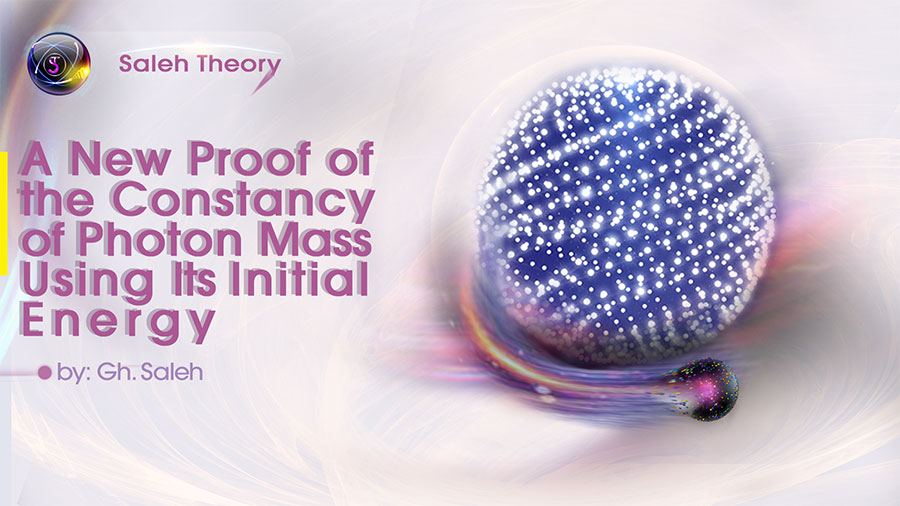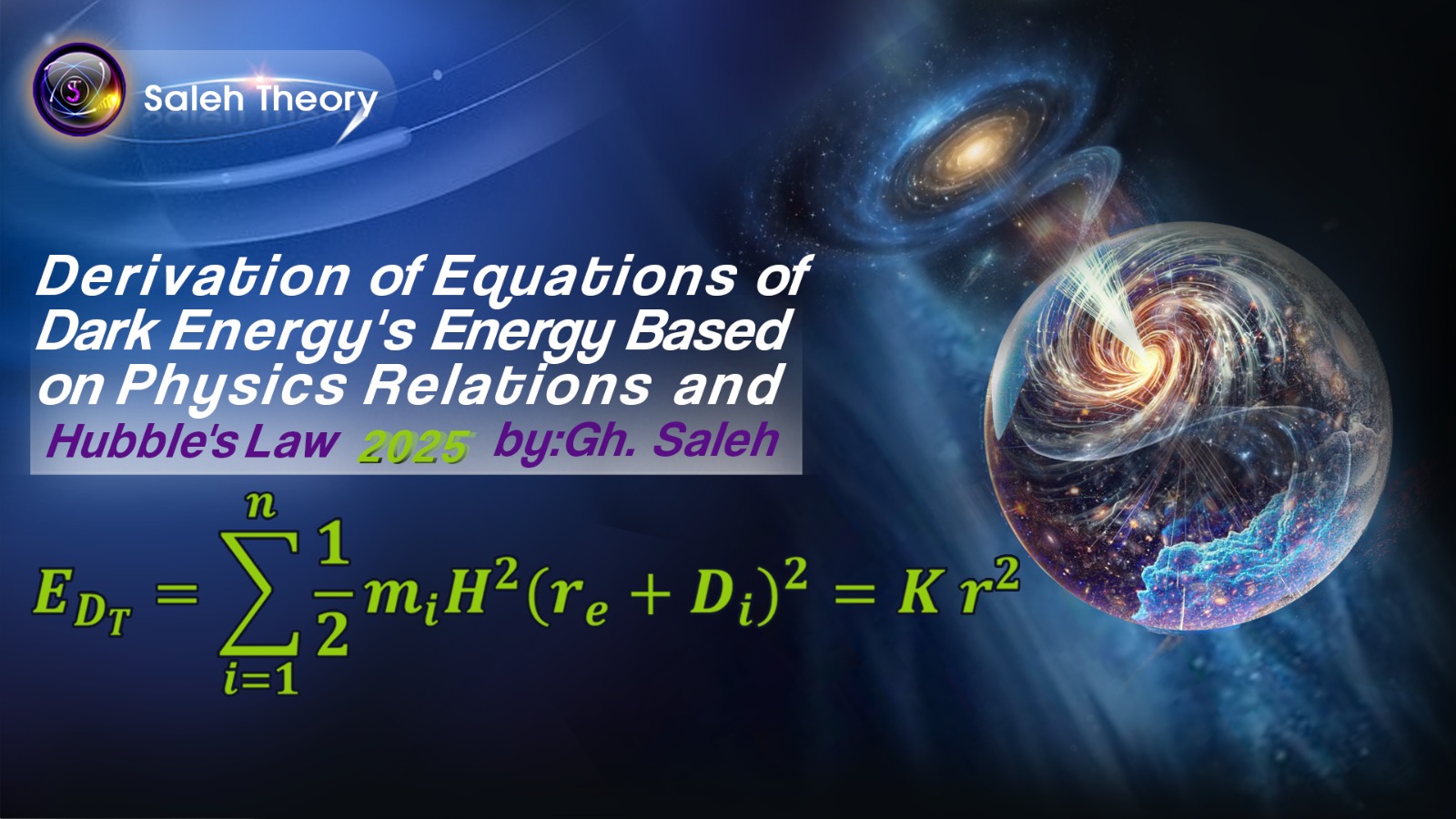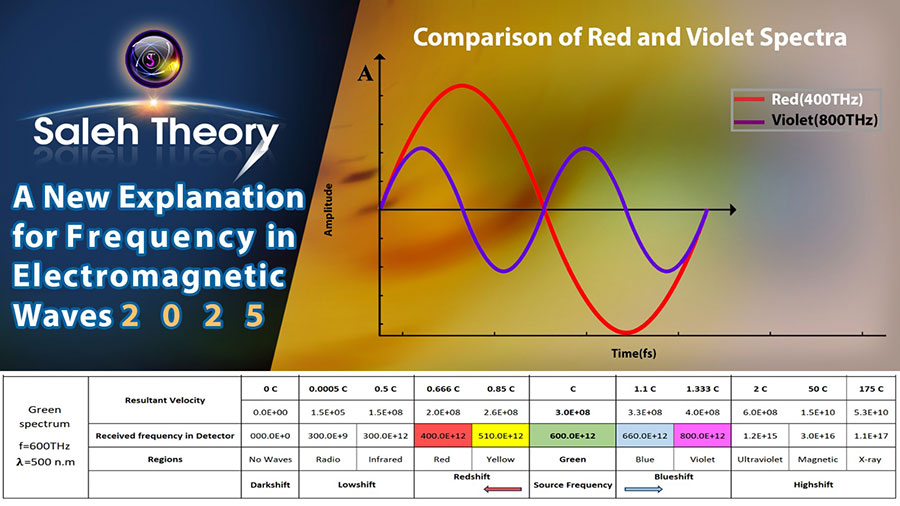
A New Explanation for Frequency in Electromagnetic Waves 2025
Consider the diagram of electromagnetic spectrum, which extends from radio waves at its lower end to gamma rays at its upper limit. Within this, lies a narrow band of visible light spectra. Focusing on two specific spectra within this band, the violet spectrum (800 THz) and the red one (400 THz), we can illustrate their wave motion graph as follows:
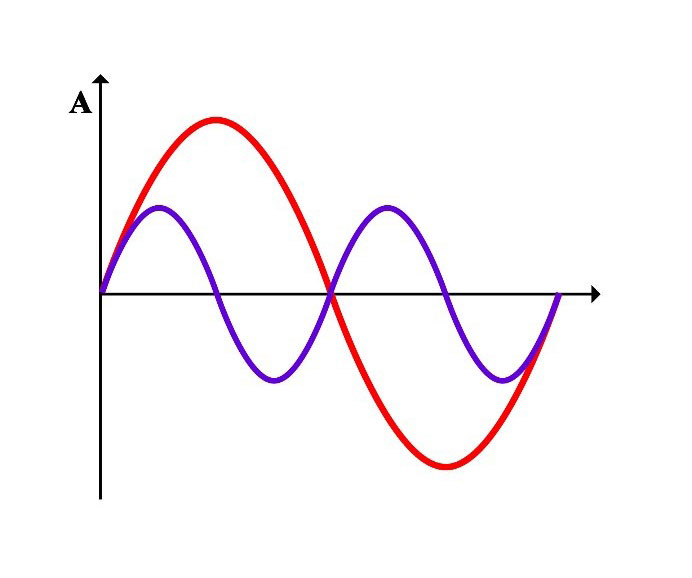
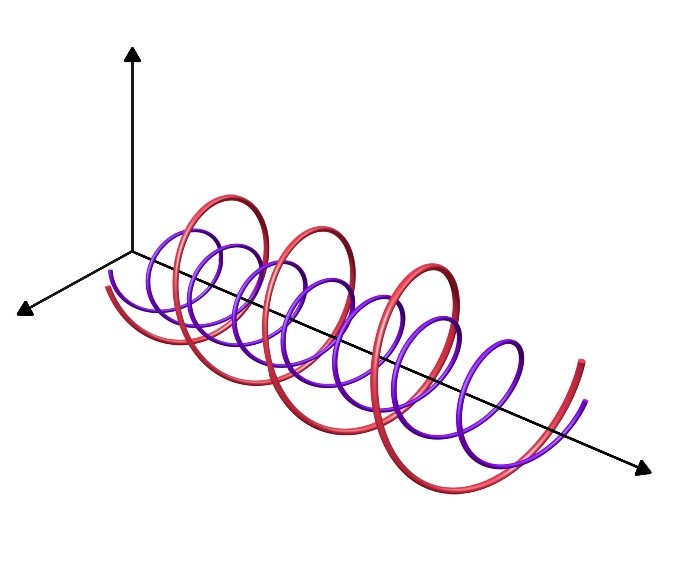
In the given example, the wavelength of the red spectrum is approximately twice that of the violet spectrum. Now, let us compare the photons of these two different spectra as they travel a wave-like path over a time interval “t.”
If a single photon of the red spectrum traverses this path, then two photons will do the same for the violet spectrum. In other words, in our example, the frequency ratio of the violet to the red spectrum is two, meaning that the number of transmitted photons in the violet spectrum within the same time duration is twice that of the red spectrum. Consequently, the amount of energy transferred by the violet spectrum will be twice that of the red spectrum.

To define the frequency for visible spectra, and more generally for electromagnetic waves, it can be described as the number of photons that arrive at the destination via wave-like motion within an equal time interval, assuming that the mass and speed of photons are constant.
In other words, the frequency of electromagnetic waves corresponds to the number of photons that impact a surface. For instance, if the wave frequency is 400 Hz, this means that 400 photons impact the target surface per second.
Notice:
It is posited that frequency, as defined herein, is determined by the quantification of photon impacts upon a target surface. Consequently, if a source moves at a fraction of the speed of light “C” in the direction of the photon path, the number of photons impacting the surface increases, resulting in an elevated observed frequency, a phenomenon termed blueshift. Conversely, if the source moves at a fraction of “C” in the opposing direction, the number of photons impacts decreases, leading to a diminished observed frequency, termed redshift.
It is proposed that the wavelength of the emitted waves remains invariant and that the observed frequency variations are solely attributable to alterations in the photon impact rate caused by the source's velocity.
Therefore, variations in source velocity result in corresponding fluctuations in observed frequency, manifesting as color changes. However, the initial wavelength of the light remains unchanged. If we eliminate the relative velocity that alters the speed, then the observed frequency returns to its initial value, and we observe the original color.
For instance, consider an observer is stationary, and a light source moves away from the observer with a velocity of 0.15C, emitting wave with a frequency of 600 THz. As a result, the resultant velocity, considering the source, the observer, and the propagation of light, is 0.85C. This change in velocity affects the frequency observed by the stationary observer, causing it to be lower than the original source frequency, leading to a redshift.
If the source's velocity increases further in the same direction, reaching, for example, 0.5C, the frequency shift becomes so significant that the observer can no longer detect the wave within the visible spectrum; instead, it shifts into the infrared (invisible) range, a phenomenon we refer to as a “lowshift”. Furthermore, if the source moves away from the observer with a velocity of C, the relative velocity between the emitted photons and the observer becomes zero. This implies that no photons from this source reach the observer, a situation we define as a “darkshift”.
Conversely, if the source approaches the stationary observer with a velocity of 0.15C, the observed frequency increases, resulting in a blueshift. If this velocity reaches 1.5C, the observer can no longer detect the wave within the visible spectrum, as it shifts into the ultraviolet range, which we term a “highshift”.
Depending on the magnitude and direction of the source's and observer's velocities, a wide range of frequency shifts could occur. Assuming that the source emits wave at a frequency of 600 THz, the table below presents the observed frequency based on the resultant velocity of the source, observer, and light.

References:
[1] Saleh, Gh. "A New Proof of the Constancy of Photon Mass Using Its Initial Energy." Saleh Theory, 06 Mar. 2025, https://www.saleh-theory.com/Article/a-new-proof-of-the-constancy-of-photon-mass-using-its-initial-energy
[2] Saleh, Gh. "Discovery of the Hundred-Year-Old Lost Mathematical and Physical Relationship Between the Classical Kinetic Energy of Photons and Planck's Everlasting Experimental Equation in the Universe (Planck-Saleh Energy Equation)." Saleh Theory, 28 Jun. 2024, https://www.saleh-theory.com/article/discovery-of-the-hundred-year-old-lost-mathematical-and-physical-relationship-between-the-classical-kinetic-energy-of-photons-and-plancks-everlasting-experimental-equation-in-the-universe-planck-saleh-energy-equation
[3] Saleh, Gh. "New, Marvelous and Revolutionary Discoveries About Photon." Saleh Theory, 07 Sep. 2023, https://www.saleh-theory.com/article/new-marvelous-and-revolutionary-discoveries-about-photon
[12] Saleh, Gh. "Photon has a Constant Rest Mass!." Saleh Theory, 16 Mar. 2018, https://www.saleh-theory.com/article/photon-has-a-constant-rest-mass
[13] Saleh, Gh. "The Unseen World of Photon." Saleh Theory, 16 Jul. 2017, https://www.saleh-theory.com/article/the-unseen-world-of-photon
[14] Saleh, Gh. "New Definition of Color Variety of Photons." Saleh Theory, 05 May. 2017, https://www.saleh-theory.com/article/new-definition-of-color-variety-of-photons
[15] Saleh, Gh. "A Revolution in Light Theory." Saleh Theory, 11 Apr. 2017, https://www.saleh-theory.com/article/a-revolution-in-light-theory
 Download PDF
Download PDF 
